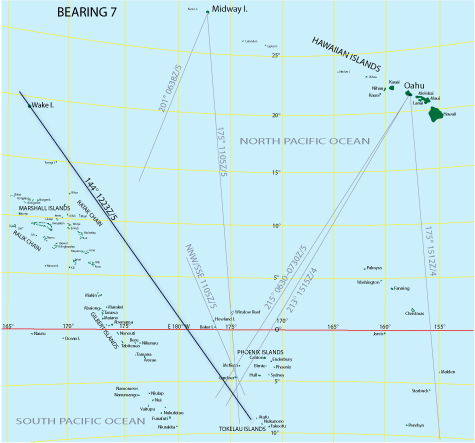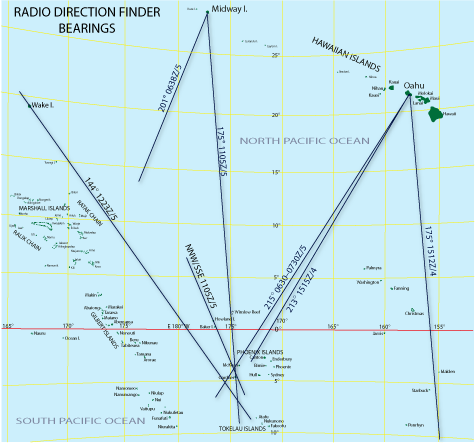 |
| RDF Analysis, page 6 |
This was a bearing of approximately 144 degrees on a signal at 3105 kHz, described by R. M. Hansen, the Wake Island supervisor72 as a “very unsteady voice modulated carrier,” with characteristics identical to those of a signal heard (without a bearing) at 1215Z the previous night, July 4, “an intermittent fone of rather wobbly characteristics,” and
voice modulated with male voice although unreadable through noise, [with signal strength that] started in at a carrier strength of QSA 5 and at 1236, when this transmission stopped it had gradually petered out to QSA 2 during the intervals when it was audible.
Hansen also said:
While no identification call letters were distinguished in either case, I was positive at that time that this was KHAQQ. At this date, I am still of this opinion. … There is not the slightest question in my mind the signals I have reported on could have been those of a maladjusted CG phone, because (1) the abnormal and erratic characteristics of these signals as compared to the steady operating CG phones. And (2), the fact that no CG boats were, to the best of my knowledge, anywhere near the line of the Wake DF bearing of 144 degrees appx.
Ambler, the Mokapu Point supervisor mentioned this signal in his report,73 stating at 1225Z:
… signal strength rises sufficiently for Wake to obtain an approximate bearing of 144 degrees. This seems to tie in fairly well with our two bearings of 213 and 215. At same time Midway reports obtaining a very poor bearing – due to swinging – of 201 degrees.and at 1350Z:Carrier heard again on 3105 but by time we could open DF signal off again.Angus, The Pacific Division Communication Superintendent, was not present at Wake Island, but stated in his report:74Wake reported signals in the vicinity of 3105 KC, obtaining an approximate bearing of 140 degrees. However, I do not believe the signals that Wake heard were from the Earhart plane inasmuch as they were unheard at Mokapu at this time. The signals heard at Wake were a continuous carrier for several minutes at a time and we were of the opinion that possibly these signals emanated from somewhere in Japan.Table 11: Potential Signal Sources for Bearing 7
Set
Z
Rise
Z
Brg
Brg
Sunset: 0736Z
Sunrise: 1820Z
Sig Brng: 144Quarry Heights Melbourne Navarin Mys Stalino Gardner Island Oust-Kiakhta San Diego acft Los Angeles acft San Francisco acft Seattle acft Billings Analysis
Click on the map to open a much larger version in a new window.
- “QSA” ratings are subjective operator estimates of signal strength on a scale of 1 to 5. “QSA 5” means “very good signal strength,” and “QSA 2” means “weak signal strength.”
- This bearing line passes approximately 70 nmi southwest of Gardner Island.
- The bearing of the Itasca at this time was 140 degrees, very close to the reported signal bearing.
- The statement by Hansen that the signal characteristics were identical to those heard at 1215Z on July 4 provides an important clue. The Itasca could not have been the source of that signal. The ship’s radio log shows no transmissions on 3105 between 0645Z and 2100Z that day. Therefore, if the characteristics of the signal of Bearing 7 were identical to those of the signal heard on July 4, the signal of Bearing 7 was not from the Itasca.
- The Itasca sent a signal to Earhart at 1223Z, logged as “ANOTHER CALL AS ABOVE // 3105,” but the log does not state the transmission mode. However, the signal referred to as “AS ABOVE” was sent in Morse code at 1213Z, asking Earhart to “INDICATE RECEPTION BY FOUR LONG DASHES AND THEN GIVE BEARING HOWLAND NORTH OR SOUTH.” Therefore, it is assumed that the 1223Z signal was sent in Morse code.
- There is a 1230Z entry in the Itasca radio log stating: “HEARD THREE DASHES / VERY RAGGED / OFF FREQ.” Since the Itasca was listening for signals on 3105 kHz at this time, it can be assumed that this signal was close to 3105. Although the character of this signal is different from that reported by Wake, this reception by the Itasca might be a serendipitous clue, unrelated to the signal of Bearing 7, in that it could have been an Earhart response to the 1223Z Itasca request for dashes. The computed SNR for the Itasca request shows that the signal could have been heard loud and clear at Gardner Island. And the computed mean SNR at the Itasca for a response from Gardner was just at the minimum level required to hear dashes, with a 50 percent chance of exceeding that level due to randomness in the propagation environment.
- Notwithstanding Angus’ assertion, failure to hear the signal at Mokapu does not imply that it wasn’t from Earhart. As for Angus’ suggestion that the signal could have originated in Japan, there were no transmitters in Japan operating on 3105 kHz, or on a frequency with a harmonic near 3105 kHz.
- Of the signal sources in Table 11, only the Siberian station at Oust-Kiakhta was near the reciprocal of the signal bearing, and the probability of hearing a signal from that station was about 900 billion times lower than for a signal from Gardner Island.
- The available evidence strongly suggests that Gardner Island was the source of the reported signal.
The Itasca sent a message75 at 0815Z on July 6 (2145 HST July 5) to the Coast Guard Commander of the Hawaiian Section (COMHAWSEC):For purpose determining corrective factor on Earhart bearing request Honolulu take bearing on Itasca on 3105 KCS at 2215 and 2315 Honolulu time also Wake at 2315 Honolulu time.The times of the requested bearings corresponded to 0845Z and 0945Z, respectively, on July 6. COMHAWSEC replied76 at 0840Z confirming the requested arrangements for the bearings at Mokapu, and advising that Wake Island would not be ready until 1145Z. The Itasca radio log shows transmissions to Earhart at 0843Z, 0945Z, 1000Z, and 1400Z. The failure to transmit at 1145Z for Wake turned out to be of no consequence because Wake77 was unable to hear signals after 0700Z “owing to the presence over and near Wake of a severe electrical storm.”COMHAWSEC78 informed the Itasca at 1208Z that Mokapu had obtained a bearing of approximately 196.5 degrees, “Believed to be on Itasca phone transmitter,” at 2317 HST (0947Z on July 6), but provided no information about signal strength, bearing accuracy, or whether the signal was heard by Coast Guard or Navy facilities in the Honolulu area. The bearing of the Itasca from Mokapu at 0947Z was 232 degrees.
Analysis
- The Itasca radio log for July 6 shows a transmission to Earhart on 3105 kHz at 0945Z and that the transmission lasted until 0948Z.
- The bearing of the Itasca was 232 degrees at 0945Z.
- The computed elevation angle of a signal arriving from the Itasca, was approximately 5 degrees. Given the 4.8-degree Koolau ridge line elevation angle on the bearing of the Itasca, terrain interference could have skewed the signal arrival direction and reduced the SNR below the level required for Mokapu to recognize that the signal was from the Itasca, and to get an accurate bearing.
- The computed elevation angle for a signal from Gardner Island was 1.5 degrees, which was below the 2.9-degree ridge line elevation angle on the bearing of Gardner, so terrain interference could have skewed the signal arrival direction and reduced the SNR below the level required for Mokapu to recognize that the signal was from the Itasca, and to get an accurate bearing.
- The only entry for July 6 (GMT) in the Mokapu supervisor’s report79 states:
Our ship enroute to Alameda therefore all our facilities in use guarding flight. Nothing heard from Coast Guard. After turning over plane guard to Alameda at 1030 3105 KC was guarded as much as possible but nothing of interest was heard.which appears to conflict with the COMHAWSEC message.- The apparent conflict between Ambler and COMHAWSEC can be explained by the following hypothetical scenario: Ambler saw that the Itasca transmissions were scheduled at times when no bearings on the Pan Am flight to Alameda flight would be required, so Mokapu could listen briefly for the Itasca signals without jeopardizing flight safety. Nothing was heard at 0845Z, but an unreadable voice signal was heard at 0947Z and a bearing of 196.5 degrees was obtained. The signal was reported to COMHAWSEC as “Believed to be on Itasca phone transmitter” based on its time proximity to the expected 0945Z signal from the Itasca. Ambler did not know the Itasca’s location at the time, and thus did not question the bearing. During the next several days prior to his report on July 10, Ambler learned the Itasca’s location at 0947Z on July 6 and concluded that the signal that was heard could not have been from the Itasca, and that the timing of the signal was coincidental. Thus, having decided that the only signal heard, at 0947Z, was not from the Itasca, Ambler wrote “Nothing heard from Coast Guard” in his report.
- The design of this test was flawed in that it failed to take into account the likely interaction of signal propagation geometry and Koolau range terrain interference. Consequently, the test results were inconclusive.
The attempt to obtain DF bearings on possible signals from Earhart was undertaken in extremely difficult conditions and yielded a total of 8 bearings. The Pan Am Adcock DF sites, which obtained 7 of the bearings, were searching for signals with SNRs far lower than those for which the DF system was designed. The DF system at Howland Island, an experimental Navy portable unit of doubtful reliability, obtained the eighth bearing.
All of the bearings were approximate at best, due to weakness and short duration of signals, and potential terrain interference effects in the case of the Mokapu site. And none of the signals included conclusive evidence as to the source identify.
Notwithstanding the lack of specific source identification, analysis of multi-dimensional circumstantial evidence has yielded important insights. The evidence associated with Bearings 2, 3, and 7 strongly supports the TIGHAR hypothesis that Earhart landed at Gardner Island and transmitted radio signals from there. The evidence associated with Bearings 1, 4, and 6 moderately supports the hypothesis, and the evidence associated with bearings 5 and 8 is inconclusive.
In sum, the weight of available evidence strongly supports the TIGHAR hypothesis.


